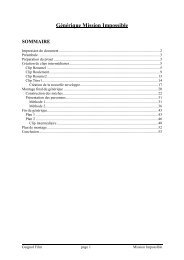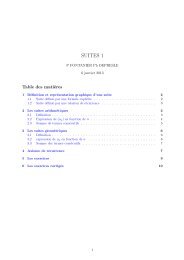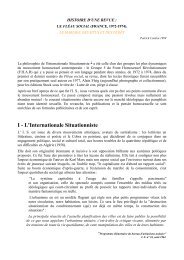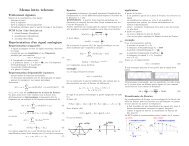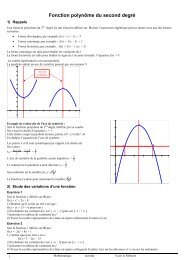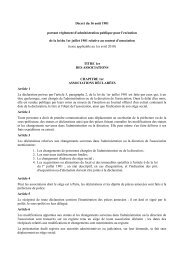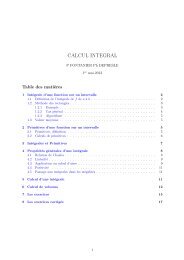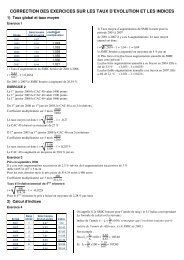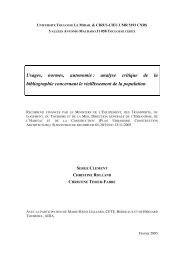internationalisation in science in the prism of bibliometric indicators
internationalisation in science in the prism of bibliometric indicators
internationalisation in science in the prism of bibliometric indicators
You also want an ePaper? Increase the reach of your titles
YUMPU automatically turns print PDFs into web optimized ePapers that Google loves.
This relative <strong>in</strong>ertia can be attributed to stable <strong>in</strong>frastructural<br />
factors, as well as feedback loops on exist<strong>in</strong>g <strong>in</strong>dividual relations.<br />
Landscape <strong>of</strong> collaboration draws more a "network" ra<strong>the</strong>r than a<br />
homogeneous "space". The national and cultural barriers are resistant.<br />
Even <strong>in</strong> an activity where exchanges are mostly immaterial, geography is<br />
far from dead. For example <strong>the</strong> degree <strong>of</strong> EU <strong>in</strong>tegration on this<br />
criterion has not followed <strong>the</strong> political impulse (Head & Mayer (2000)<br />
show <strong>the</strong> same f<strong>in</strong>d<strong>in</strong>gs on <strong>in</strong>tra-EU commercial exchanges). From <strong>the</strong><br />
methodological po<strong>in</strong>t <strong>of</strong> view, progresses are expected from <strong>the</strong> new<br />
tools <strong>of</strong> social networks <strong>the</strong>ory that could help to bridge micro and<br />
macro-approaches <strong>of</strong> scientific networks.<br />
Turn<strong>in</strong>g to <strong>the</strong> world distribution <strong>of</strong> scientific output, <strong>the</strong><br />
geographical distribution <strong>of</strong> knowledge production shows a decl<strong>in</strong>e <strong>of</strong><br />
concentration, but at a very slow pace, <strong>in</strong> <strong>the</strong> universes considered<br />
(World, OECD, EU15). The evolution <strong>of</strong> concentration <strong>of</strong> output and<br />
citations on <strong>the</strong> one hand, <strong>the</strong> convergence <strong>in</strong> per capita publication<br />
and citation on <strong>the</strong> o<strong>the</strong>r hand suggest that <strong>the</strong> picture <strong>of</strong> world<br />
<strong>science</strong> production is slowly becom<strong>in</strong>g less unequal. While "emerg<strong>in</strong>g<br />
countries", especially <strong>in</strong> Asia and also <strong>in</strong> Europe, are on a catch-up<br />
trajectory <strong>in</strong> <strong>the</strong> last decades, <strong>the</strong> periphery does not participate <strong>in</strong><br />
<strong>the</strong> movement. The pressure <strong>of</strong> newcomers mechanically shr<strong>in</strong>ks <strong>the</strong><br />
relative share <strong>of</strong> dom<strong>in</strong>ant countries <strong>in</strong> <strong>the</strong> scientific communication,<br />
but to a very moderate extent. If <strong>the</strong> case <strong>of</strong> Ch<strong>in</strong>a is spectacular,<br />
relative rank<strong>in</strong>gs <strong>of</strong> OECD countries <strong>in</strong> p.c. output have little changed<br />
<strong>in</strong> <strong>the</strong> decade. The o<strong>the</strong>r major phenomenon, <strong>the</strong> <strong>in</strong>tensive dra<strong>in</strong><strong>in</strong>g <strong>of</strong><br />
human resources by <strong>the</strong> US, also limits <strong>the</strong> long-term prospect <strong>of</strong><br />
convergence. The <strong>the</strong>matic specialisation, measured at <strong>the</strong> discipl<strong>in</strong>e<br />
level, does not give evidence <strong>of</strong> a convergence process. Scientific<br />
specialisation, rooted <strong>in</strong> historical trajectories <strong>of</strong> NSI, resists,<br />
except a slow homogenisation process with<strong>in</strong> EU15. Let us conclude by a<br />
few <strong>in</strong>terrogations.<br />
<strong>in</strong>teraction <strong>of</strong> <strong><strong>in</strong>ternationalisation</strong> modes<br />
The above perspectives on <strong><strong>in</strong>ternationalisation</strong> are not <strong>in</strong>dependent.<br />
Collaboration as a merge <strong>of</strong> complementary skills can be <strong>in</strong>terpreted as<br />
a response to <strong>the</strong> diversity <strong>of</strong> subjects and specialisation <strong>of</strong><br />
competencies. However <strong>the</strong> precise relation is critically scaledependent<br />
s<strong>in</strong>ce close specialisation pr<strong>of</strong>iles at large scale is ra<strong>the</strong>r<br />
favourable to collaboration whereas close pr<strong>of</strong>iles at small scales<br />
dries out complementarity. The relation <strong>of</strong> <strong>in</strong>ternational collaboration,<br />
output growth and geographic distribution <strong>of</strong> output is also complex.<br />
Collaboration clearly allows to <strong>in</strong>crease output (number <strong>of</strong><br />
publications) for fixed <strong>in</strong>put, giv<strong>in</strong>g some impetus to collaborative<br />
actors' productivity, with<strong>in</strong> and between countries. Large countries<br />
<strong>of</strong>fer a variety <strong>of</strong> <strong>in</strong>-house collaboration targets so that <strong>the</strong>y can<br />
afford low levels <strong>of</strong> foreign l<strong>in</strong>kages (USA, Japan). At <strong>the</strong> opposite<br />
peripheral countries exhibit very high rates <strong>of</strong> <strong>in</strong>ternational<br />
collaboration, as a response to scarcity <strong>of</strong> local resources (e.g.<br />
Gaillard et al. 2002). A reasonable hypo<strong>the</strong>sis conveyed <strong>in</strong> literature




